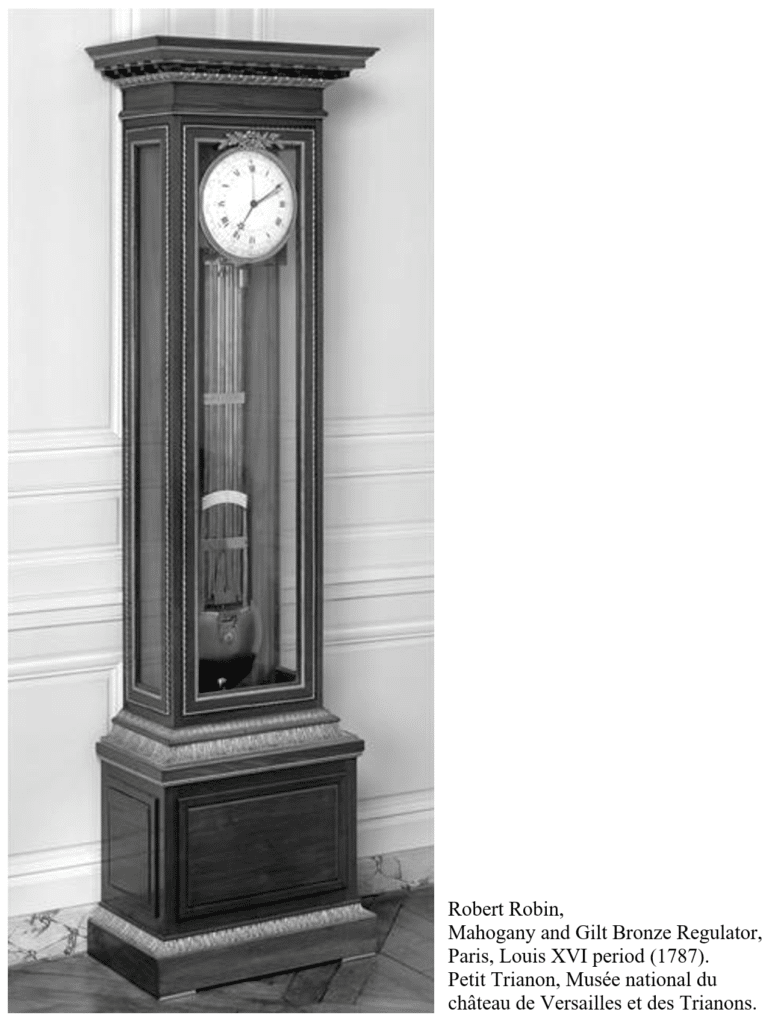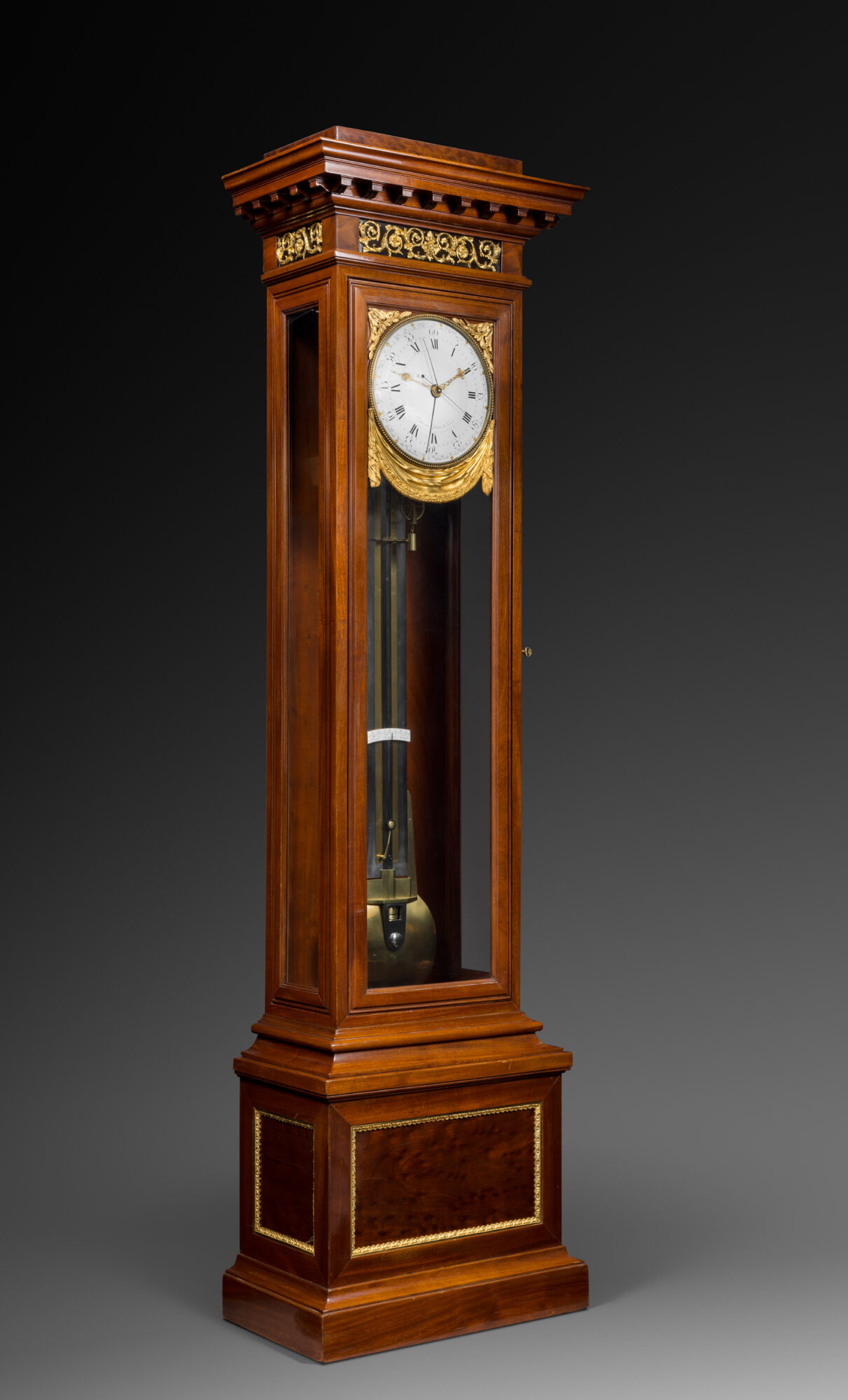Important Regulator with Equation of Time and Remontoire d’Egalité

Dial signed “Robin aux Galeries du Louvre” by clockmaker Robert Robin
Case attributed to Ferdinand Schwerdfeger
Dial attributed to Joseph Coteau
Paris, late Louis XVI period, circa 1785-1788
The enamel dial, signed “Robin aux Galeries du Louvre”, indicates the hours in Roman numerals, the annual calendar including the months and the days, and the difference between solar time and mean time (the equation of time) with two minute hands; there is a central seconds hand. The gridiron balance features a pyrometer with double graduation, marked Froid, Tempéré and Chaud, indicating the expansion of the metals. The elegant glazed mahogany veneered case with dentilled cornice is surmounted by a sloping pediment. The bronze mounts are finely chased and gilt: the dial is framed by scrolling motifs, drapery and beading; the base is embellished by leaf and flower friezes; beneath the entablature there are three pierced friezes made up of scrolling motifs.
This regulator, made by celebrated horologist Robert Robin (1742-1799) in the final years of the 18th century, is one of the finest of its kind. The attribution of the case to Schwerdfeger is based on a number of similarities with other works by this renowned cabinetmaker, as well as on information drawn from auction catalogues of the early 19th century, for example the following from a catalogue of 1823: “A very fine regulator by Robin the elder, clockmaker to Louis XVI, with equation and compensation; the solid mahogany case by Ferdinand”. The enamel dial may confidently be attributed to Joseph Coteau, since an example with a nearly identical dial signed “Robin aux Galeries du Louvre” and “Coteau 1787”, is in the Crijns collection in Breda (see ANCAHA, Winter 1997, n° 80, p. 41).
Among the comparable known Robin regulators, one is in the Paris Conservatoire des Arts et Métiers (illustrated in ANCAHA, May 1977, n° 18, p. 86, fig. 23a); another is in the Musée Paul Dupuy in Toulouse (see R. Mühe and Horand M. Vogel, Horloges anciennes, Fribourg, 1978, p. 287, fig. 581); a further example, acquired by Louis-Philippe in 1837, is in the Petit Trianon in Versailles (see S. de Ricci, Le style Louis XVI, Paris, ill. 253).
Robert Robin (1741 - 1799)
Having become a master horologist in November 1767, he was one of the most important Parisian horologists of the last third of the 18th century. He received the honorary titles of Valet de Chambre-Horloger Ordinaire du Roi et de la Reine in 1783 and 1786. He enjoyed an extraordinary career, distinguishing himself by his exceptional contribution toward the improvement of time measuring instruments.
In 1778, the Academy of Sciences approved two of his inventions, one of which led to the construction of an astronomic clock with a meridian traced on a pyramid, which was acquired by the Menus Plaisirs for Louis XVI that same year; Robin published a very detailed historical and mechanical description of that clock. He also made mantel regulators with astronomic indications and compensation balance, of which the Marquis de Courtanvaux, a man of science and a great connoisseur of precision horology, was one of the earliest acquirers. During the Revolution he made decimal watches and clocks. He worked in the Grande rue du Faubourg Saint-Honoré (1772), the rue des Fossés-Saint-Germain l’Auxerrois (1775), the rue Saint-Honoré in the l’Hôtel d’Aligre (1778) and the Galeries du Louvre in 1786.
For his desk regulators, Robin chose very sober architectural cases, which look extraordinarily modern to contemporary viewers. He always worked with the finest artisans of the day, including the bronziers and chasers Robert and Jean Baptiste Osmond, Pierre Philippe Thomire, François Rémond and Claude Galle, the cabinetmakers Jean-Henri Riesener, Ferdinand Schwerdfeger and Adam Weisweiler, the enamellers Barbezat, Dubuisson, Merlet and Coteau for the dials, and Richard and Montginot for the springs.
Robert Robin’s two sons, Nicolas Robert (1775-1812) and Jean-Joseph (1781-1856), were also fine clockmakers and ably continued to run their father’s workshop.
Discover our entire collection of rare clocks on La Pendulerie Paris.
Ferdinand Schwerdfeger (1734 - 1818)
Ferdinand Schwerdfeger is one of the most important Parisian cabinetmakers of the late 18th century. After becoming a master in May 1786, he opened a workshop in Paris and quickly gained a following. His work, however, remains little known due to his becoming a master shortly before the Revolution, and to the fact that he rarely stamped his work. Among the pieces that may be attributed to him with certitude, one should mention an ensemble delivered to Marie-Antoinette, as well as several regulator and clock cases for some of the finest horologists of the day, including Antide Janvier, Jean-Simon Bourdier and Robert Robin (see M-A Paulin, Schwerdfeger, ébéniste de Marie-Antoinette, in L’Estampille/L’Objet d’art, October 2003).
Joseph Coteau (1740 - 1801)
The most renowned enameller of his time, he worked with most of the best contemporary Parisian clockmakers. He was born in Geneva, where he was named master painter-enameler of the Académie de Saint Luc in 1766. Several years later he settled in Paris, and from 1772 to the end of his life, he was recorded in the rue Poupée. Coteau is known for a technique of relief enamel painting, which he perfected along with Parpette and which was used for certain Sèvres porcelain pieces, as well as for the dials of very fine clocks. Among the pieces that feature this distinctive décor are a covered bowl and tray in the Sèvres Musée national de la Céramique (Inv. SCC2011-4-2); a pair of “cannelés à guirlandes” vases in the Louvre Museum in Paris (see the exhibition catalogue Un défi au goût, 50 ans de création à la manufacture royale de Sèvres (1740-1793), Musée du Louvre, Paris, 1997, p. 108, catalogue n° 61); and a ewer and the “Comtesse du Nord” tray and bowl in the Pavlovsk Palace in Saint Petersburg (see M. Brunet and T. Préaud, Sèvres, Des origines à nos jours, Office du Livre, Fribourg, 1978, p. 207, fig. 250). A blue Sèvres porcelain lyre clock by Courieult, whose dial is signed “Coteau” and is dated “1785”, is in the Musée national du château in Versailles; it appears to be identical to the example mentioned in the 1787 inventory of Louis XVI’s apartments in Versailles (see Y. Gay and A. Lemaire, “Les pendules lyre”, in Bulletin de l’Association nationale des collectionneurs et amateurs d’Horlogerie ancienne, autumn 1993, n° 68, p. 32C).









